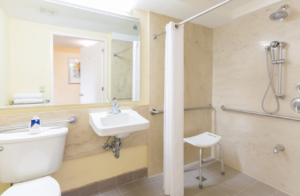Most people, in fact 90% according to an AARP research report, who are over the age of 65, would prefer to stay in their home for as long as they possibly can. However, aging in place often requires significant renovations. Changes must be made so that an older person remains comfortable and safe as they become less physically able to navigate their homes. One of the most important areas of renovation is the bathroom. Age in place bathroom design is about negating potential risks in the bathroom without sacrificing style or comfort.
Why is Age in Place Bathroom Design so Important?
A study by the Centers for Disease Control and Prevention found that an incredible 50% of people over 85 years of age who are injured badly enough to need to go to the emergency room are injured near the toilet. It isn’t hard to realize why the bathroom can be such a dangerous place for the elderly.
Floors that tend to be slippery, lots of hard surfaces, and temperature changes getting in and out of the shower or tub make the bathroom a risky place. Aging in place bathroom design decisions can do a lot to reduce the risks that bathrooms can pose for the elderly.
How to Create a Senior Citizen Bathroom Design for Elderly Residents
Deciding what to focus on in a bathroom remodel for elderly residents can be challenging. These kinds of renovations can be expensive. There are lots of decisions to make about exactly how extensive the remodel needs to be. A good way to organize your priorities is by looking at how injuries tend to occur in the bathroom according to the report by the Centers for Disease Control.
81% of injuries are due to a fall. The majority of injuries occur while people are bathing. Miscellaneous injuries are the next most common, followed by slipping and using the toilet. Leaving the tub, fainting, entering the tub, and tripping are at the end of the list. Over 60% of injuries occur in or around the tub or shower, while only around 20% occur around the toilet.
How do you remodel a bathroom for aging in place?
The tub is the most common place that injuries occur.Therefore, to remodel a bathroom for aging in place, focus on eliminating potential safety hazards in the tub and in the process of getting in and out of the tub. Also, focus on reducing falls, since the vast majority of injuries are because of falls.
Aging in Place Shower Design
Can’t imagine life without a good soak in the tub? A walk-in tub will likely be part of your aging in place bathroom. Traditional tubs are difficult to get in and out of for people with mobility concerns. Typical shower tub combos make it difficult to take a shower or soak in the tub.
What is the best shower for aging in place?
A walk in tub shower combo may be a good solution for smaller bathrooms. If you don’t need a tub, a curbless shower is a great solution. This is one of the few aging in place home modifications that actually makes your home more stylish. Curbless showers look great, and they make taking a shower as easy as walking or rolling your wheelchair in.
Whatever kind of shower or tub you choose, here are some things to look for:
- Built-in benches make it easy to sit and relax while you take a shower or transition from a wheelchair to the bench
- Adjustable shower heads are essential, particularly if you’re creating an aging in place shower design for someone who uses a wheelchair
- Ensure that there are sufficient grab bars for getting into and out of the shower or tub.
- Look for conveniently located niches and trays for your soap, shampoo, etc
Toilets for Aging in Place
Higher toilets are typically easier for older people to use. It’s easier to sit down and stand up when you don’t have as far to go. Of course, if you use a wheelchair, you’ll want to choose a handicap accessible toilet.
Grab bars by the toilet are essential, regardless of what kind of toilet you choose. If you’re doing a complete bathroom remodel for elderly residents, you may want to consider putting in a toilet/bidet combination. The bidet feature can be very helpful for elderly people that may struggle to maintain good hygiene as they get older.
When positioning the toilet and considering overall aging in place bathroom dimensions in your design, make sure you leave enough room in front of the toilet for a wheelchair to turn around.
Other Considerations in Senior Citizen Bathroom Design for Elderly People
- Good lighting. Falls and accidents are less likely if the lighting is good.
- A call button. If you have safety alert buttons in your home, the bathroom is an essential place to put one.
- Non-slip floors. Floors with good grip can be a challenge in a bathroom. One option is textured tile or viny. It has the benefit of being able to extend into a curbless shower. If you don’t want to redo the floors big, sturdy rugs with good grip on the tile are a possible solution.
- Wide doorways. If you are doing a complete aging in place bathroom redesign, it’s a good idea to widen doorways to accommodate a wheelchair
- Adjust access. An elderly person who can’t reach as far up or down or is in a wheelchair may struggle to access bathroom supplies and equipment. Adjust the height of mirrors, sinks, cabinets, etc to fit the needs of the person using them.
FAQ
How much does a walk-in shower cost for seniors?
Expect to pay between $3,500 and $15,000 for a walk-in shower, depending on the size, features, and style. Walk-in shower tub combinations typically run a little bit higher. Curbless showers with tile that extends throughout the bathroom and into the shower are also more expensive.
How wide should a bathroom door be for aging in place?
According to the National Association of home builders, doors for an aging in place bathroom should be at least 32 in wide, which means you’ll need a 36-in door. Wider doors better accommodate wheelchairs.
How tall should an age in place toilet be?
An age in place toilet should be two and a half inches taller than a standard toilet. Toilet designed for wheelchair users may also have additional bracing around them to make them easier to use.




